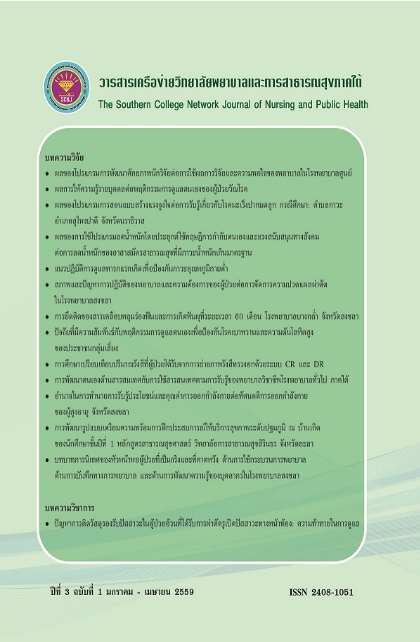แนวปฏิบัติการดูแลทารกแรกเกิดเพื่อป้องกันภาวะอุณหภูมิกายต่ำ
คำสำคัญ:
แนวปฏิบัติ, การดูแลทารกแรกเกิด, ภาวะอุณหภูมิกายต่ำ, Practice Guideline, Newborn Care, Hypothermiaบทคัดย่อ
การวิจัยนี้มีวัตถุประสงค์เพื่อศึกษาความเหมาะสม และความเป็นไปได้ของแนวปฏิบัติการดูแลทารกแรกเกิดเพื่อป้องกันภาวะอุณหภูมิกายต่ำ ดำเนินการวิจัยเป็น 3 ขั้นตอน คือ ขั้นตอนที่ 1 พัฒนาแนวปฏิบัติการดูแลทารกแรกเกิดเพื่อป้องกันภาวะอุณหภูมิกายต่ำโดยการทบทวนแนวคิด ทฤษฎี และงานวิจัยที่เกี่ยวข้องสรุปเป็นแนวปฏิบัติผ่านการตรวจสอบความตรงตามเนื้อหาจากผู้ทรงคุณวุฒิ 3 คน ขั้นตอน ที่ 2 ตรวจสอบความเหมาะสมของแนวปฏิบัติจากผู้เชี่ยวชาญ จำนวน 7 คน เครื่องมือที่ใช้เป็นแบบสอบถามแนวปฏิบัติ วิเคราะห์ข้อมูลโดยวิเคราะห์เชิงเนื้อหา ขั้นตอนที่ 3 การตรวจสอบความเป็นไปได้ของแนวปฏิบัติ กลุ่มตัวอย่างคือพยาบาลวิชาชีพที่ปฏิบัติงานเกี่ยวกับการดูแลทารกแรกเกิด ในจังหวัดสงขลา จำนวน 32 คน สุ่มตัวอย่างแบบสุ่มอย่างง่าย หาค่าความเชื่อมั่นโดยหาค่าสัมประสิทธิ์แอลฟาของครอนบาค เท่ากับ .93 วิเคราะห์ข้อมูลโดยใช้ค่าเฉลี่ย ส่วนเบี่ยงเบนมาตรฐาน และสถิติทดสอบที (One – Sample t-test) ผลการวิจัยพบว่า
แนวปฏิบัติการดูแลทารกแรกเกิดเพื่อป้องกันภาวะอุณหภูมิกายต่ำประกอบด้วย 15 ข้อ ได้แก่ 1) การปรับอุณหภูมิห้องคลอดที่ 26° C 2) เปิดเครื่อง Radiant Warmer ก่อนคลอด 15 นาที 3) ผ้ารับเด็กเปิดเตรียมใต้ Radiant Warmer 4) ปิดแอร์ทันทีที่คลอดหรือคลอดเร็ว 5) หลังตัดสายสะดือ นำผ้าที่อุ่นมาเช็ดตัวทารก แล้วอุ้มให้มารดาดูเพศ 6) นำทารกให้มารดาอุ้มเนื้อแนบเนื้อร่วมกับดูดนมแม่นาน 5-10 นาทีพร้อมกับใช้ผ้าห่มตัวทารก 7) กิจกรรมการตกแต่งสายสะดือ ผูกป้ายข้อมือทำใต้ Radiant Warmer 8) กิจกรรมตรวจร่างกาย ฉีดยา หยอดตา ป้ายสะดือ ทำใต้ Radiant Warmer 9) วัดอุณหภูมิกายทางทวารหนักโดยใช้เทอร์โมมิเตอร์แบบกระเปาะแก้ว 10) ชั่งน้ำหนักทารกโดยใช้กระดาษฟางรองก่อน 11) ทารกได้รับการห่อตัวด้วยเสื้อผ้าเด็ก ผ้าอ้อม และห่ออีกชั้นด้วยผ้าห่อ 1 ผืนที่ได้ผ่านการอุ่นใต้ Radiant Warmer การสวมหมวก และเจ้าหน้าที่อุ้มไปให้มารดาหลังคลอด 12) หลังคลอด 2 ชั่วโมง ให้เปิดแอร์ที่อุณหภูมิ 27° C ห้ามเปิดพัดลม 13) ดูแลทารกแรกเกิดหลังคลอด ñ 2 ชั่วโมงหลังคลอด โดยวัดสัญญาณชีพ ทุก 30 นาที จำนวน 2 ครั้ง และ 1 ชั่วโมง จำนวน 1 ครั้ง 14) ไม่ให้ทารกหลังคลอดนอนแช่ปัสสาวะหรืออุจจาระ 15) หลังคลอดครบ 2 ชั่วโมง ย้ายทารกไปตึกหลังคลอดด้วยคลิปเด็ก โดยห่อตัวด้วยผ้าอ้อมและ ผ้าขนหนูอีก 1 ชั้น ทั้งนี้ แนวปฏิบัติทั้ง 15 ข้อมีความเหมาะสมต่อการนำไปปฏิบัติโดยมีข้อเสนอแนะเพิ่มเติมในประเด็นการควบคุมอุณหภูมิของห้องคลอด การตั้งค่าอุณหภูมิของ Radiant Warmer หลักการทำ Skin to Skin และวิธีการเคลื่อนย้ายทารกหลังคลอดกับ Transfer Incubator และมีความเป็นไปได้สู่การนำไปปฏิบัติ อย่างมีนัยสำคัญทางสถิติที่ระดับ .05, .01 และ .001
Practice Guidelines for Prevention of Hypothermia Among Newborn Patients
This research aimed to develop the suitability and relevance of some new practice guidelines into the prevention of hypothermia among newborn patients. The research was divided into 3 phases. Phase 1 was a development of practice guidelines by literature review (concept, theory, and related research), and a confirmation of its content validity by a panel of three experts. Phase 2 was an examination of the suitability of those practice guideline by seven specialists, by using a questionnaire regarding the practice guidelines as a research instrument, and by analyzing data using content analysis. Phase 3 was a determination of the applicability of the practice guidelines. Sample was 32 registered nurses who were currently working in the area of neonatal care in Songkhla province, Southern Thailand. Simple random sampling was used. The reliability was tested using Cronbach’s Alpha Coefficient and equal to 0.93. Data were analyzed using mean, standard deviation, and one-sample t-test.
The results showed that the practice guidelines for prevention of hypothermia among newborn patients included the following 15 recommendations: 1) adjusting temperature in the labor room at 26° C, 2) turning on a radiant warmer 15 minutes before delivery, 3) preparing a sheet for the newborn by putting it under a radiant warmer, 4) turning off any air conditioning as soon as delivery or precipitated labor, 5) using a warm cloth to wipe a newborn after cutting the umbilical cord and taking the newborn to his/ her mother to seeing the gender of the newborn, 6) taking the newborn to his/her mother for a 5-10 minute period of breast feeding, then let the mother hold her baby with skin contact, and using a blanket for the baby, 7) taking care of the newborn’s umbilical cord, tying a wrist band for the newborn under a radiant warmer, 8) taking a newborn’s physical examination, by giving injection and eye drops, and painting the newborn’s navel under a radiant warmer, 9) measuring the body’s temperature of the newborn using a rectal thermometer, 10) weighing the newborn by using a thin paper under his/her back, 11) wrapping the baby with clothes, diaper, and a newborn’s sheet that had been warmed under a radiant warmer, using a newborn’s hat, and bringing the newborn to his/her mother, 12) after two hours, setting the temperature of air conditioning at 27° C, and no turning on any fan, 13) nursing care for newborn at birth until two hours after birth by measuring twice vital signs every 30 minutes, and one more time 1 hour later, 14) keeping the newborn from his/her urine or feces, 15) after 2 hours of birth, moving the newborn to a postpartum ward using a baby crib, and wrapping the newborn with diaper and towel. Those 15 recommendations in the practice guidelines were suitable with a statistically significant level (p<.05). And the feasibility of implementation was statistically significant (p<.01). Further suggestions of these guidelines are controlling temperature in the labor room, setting the temperature of the radiant warmer, systematically applying the principle of doing a skin to skin contact, and other guidelines in how to move a newborn into an incubator transfer unit.
ดาวน์โหลด
เผยแพร่แล้ว
ฉบับ
ประเภทบทความ
สัญญาอนุญาต
1. บทความหรือข้อคิดเห็นใด ๆ ที่ปรากฏในวารสารเครือข่าย วิทยาลัยพยาบาลและการสาธารณสุขภาคใต้ ที่เป็นวรรณกรรมของผู้เขียน บรรณาธิการหรือเครือข่ายวิทยาลัยพยาบาลและวิทยาลัยการสาธารณสุขภาคใต้ ไม่จำเป็นต้องเห็นด้วย
2. บทความที่ได้รับการตีพิมพ์ถือเป็นลิขสิทธิ์ของ วารสารเครือข่ายวิทยาลัยพยาบาลและการสาธารณสุขภาคใต้








